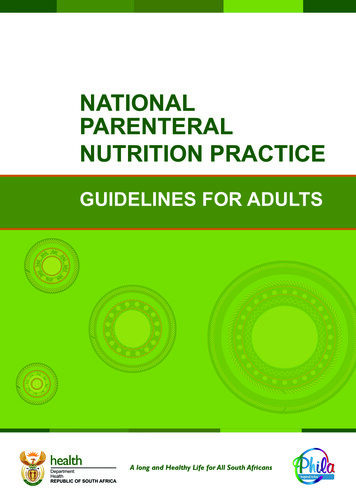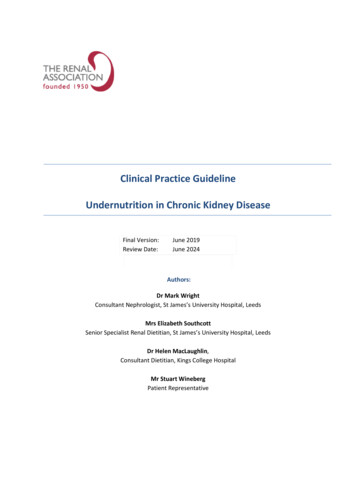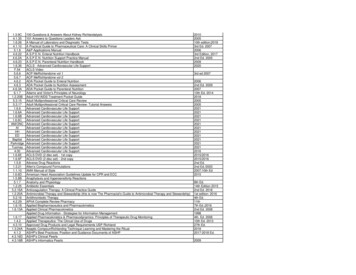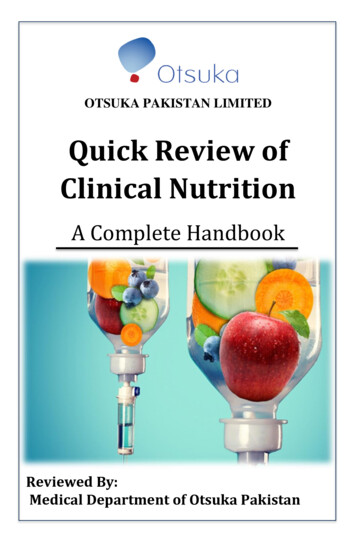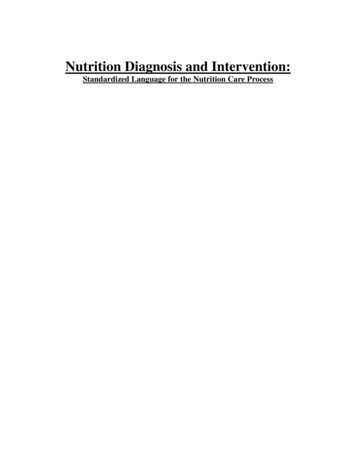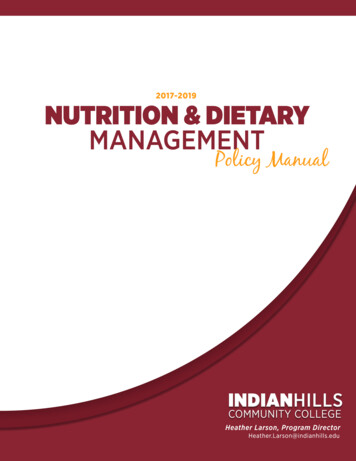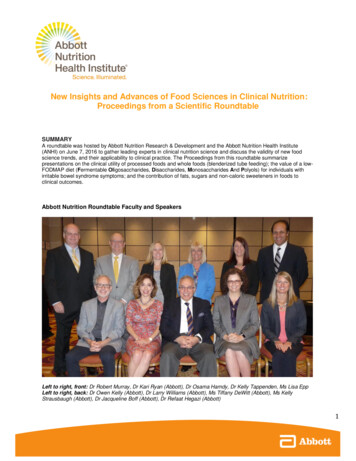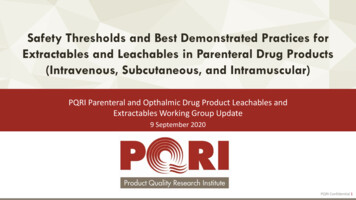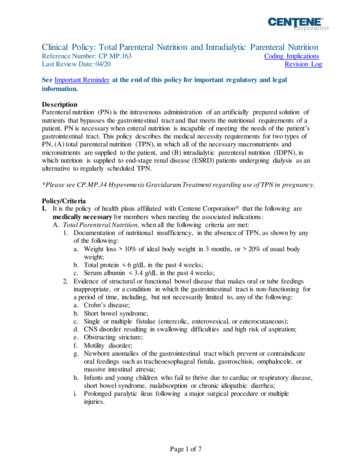
Transcription
Clinical Policy: Total Parenteral Nutrition and Intradialytic Parenteral NutritionReference Number: CP.MP.163Last Review Date: 04/20Coding ImplicationsRevision LogSee Important Reminder at the end of this policy for important regulatory and legalinformation.DescriptionParenteral nutrition (PN) is the intravenous administration of an artificially prepared solution ofnutrients that bypasses the gastrointestinal tract and that meets the nutritional requirements of apatient. PN is necessary when enteral nutrition is incapable of meeting the needs of the patient’sgastrointestinal tract. This policy describes the medical necessity requirements for two types ofPN, (A) total parenteral nutrition (TPN), in which all of the necessary macronutrients andmicronutrients are supplied to the patient, and (B) intradialytic parenteral nutrition (IDPN), inwhich nutrition is supplied to end-stage renal disease (ESRD) patients undergoing dialysis as analternative to regularly scheduled TPN.*Please see CP.MP.34 Hyperemesis Gravidarum Treatment regarding use of TPN in pregnancy.Policy/CriteriaI. It is the policy of health plans affiliated with Centene Corporation that the following aremedically necessary for members when meeting the associated indications:A. Total Parenteral Nutrition, when all the following criteria are met:1. Documentation of nutritional insufficiency, in the absence of TPN, as shown by anyof the following:a. Weight loss 10% of ideal body weight in 3 months, or 20% of usual bodyweight;b. Total protein 6 g/dL in the past 4 weeks;c. Serum albumin 3.4 g/dL in the past 4 weeks;2. Evidence of structural or functional bowel disease that makes oral or tube feedingsinappropriate, or a condition in which the gastrointestinal tract is non-functioning fora period of time, including, but not necessarily limited to, any of the following:a. Crohn’s disease;b. Short bowel syndrome;c. Single or multiple fistulae (entercolic, enterovesical, or enterocutaneous);d. CNS disorder resulting in swallowing difficulties and high risk of aspiration;e. Obstructing stricture;f. Motility disorder;g. Newborn anomalies of the gastrointestinal tract which prevent or contraindicateoral feedings such as tracheoesophageal fistula, gastroschisis, omphalocele, ormassive intestinal atresia;h. Infants and young children who fail to thrive due to cardiac or respiratory disease,short bowel syndrome, malabsorption or chronic idiopathic diarrhea;i. Prolonged paralytic ileus following a major surgical procedure or multipleinjuries.Page 1 of 7
CLINICAL POLICYTotal Parenteral Nutrition and Intradialytic Parenteral NutritionInitial approval duration for TPN is for 3 months. Continued approval duration is 6months, given that the member has no evidence of unacceptable complications fromtreatment, and documentation supports positive response to therapy.B. Intradialytic Parenteral Nutrition, when all the following criteria are met:1. Meets TPN criteria in section A;2. Patient has ESRD;3. Patient is undergoing hemodialysis;4. IDPN is offered as an alternative to regularly scheduled TPN.Initial approval duration for IDPN is for 3 months. Continued approval duration is 6months, given that the member has no evidence of unacceptable complications fromtreatment and documentation supports positive response to therapy.II. It is the policy of health plans affiliated with Centene Corporation that the followingindications are experimental/investigational:A. Total Parenteral Nutrition:1. Children who were previously well nourished or mildly malnourished, who areundergoing oncologic treatment associated with a low nutrition risk (e.g. lessadvanced disease, less intense cancer treatments, advanced disease in remissionduring maintenance treatment);2. Patients with advanced cancer whose malignancy is documented as unresponsive tochemotherapy or radiation therapy;3. Patients for whom liver transplantation is not feasible and whose prognosis will notchange in spite of TPN therapy;B. Intradialytic Parenteral Nutrition, when any of the following criteria are met:1. IDPN treatments offered in addition to regularly scheduled infusions of TPN;2. IDPN treatments in patients who are suffering from acute kidney injury and who donot have ESRD.BackgroundTotal Parenteral NutritionTPN is the delivery of macronutrients (i.e. proteins, fats, and carbohydrates) and micronutrients(i.e. vitamins, minerals, and trace elements) intravenously. TPN is indicated in situations forwhich the gastrointestinal tract is incapable of digesting nutrients through enteral (oral or feedingtube) nutrition. Short-term TPN is delivered peripherally through a subclavian, internal jugular,or a femoral central venous catheter while long-term TPN requires a tunneled central venouscatheter, such as a Hickman, Groshong catheter, or an implanted infusion port.1Some of the advantages of TPN include the ease of administration, easier correction of fluid andelectrolyte disturbances, and the ability to manage nutrition in the setting of mucositis.However, some disadvantages of TPN include, catheter-associated infections, fluid overload,hyperglycemia, catheter-associated thrombosis, hepatic thrombosis, hepatic dysfunction, bloodelectrolyte abnormalities, and enterocyte atrophy. 2American Gastroenterological AssociationPage 2 of 7
CLINICAL POLICYTotal Parenteral Nutrition and Intradialytic Parenteral NutritionLong-term PN is indicated for patients with prolonged gastrointestinal tract failure that preventsthe absorption of adequate nutrients to sustain life. 7Intradialytic Parenteral NutritionMalnutrition presents an ongoing concern with patients receiving chronic hemodialysis orperitoneal dialysis. Malnutrition can occur in between 20-70% of patients, and there is a positiveassociation with length of time on dialysis and increasing decline in nutritional parameters.IDPN is delivered during dialysis for patients who continue to lose weight or have very lowserum albumin ( 3.4 g/dL) despite oral supplements and for those with severe gastroparesis whomay be unable to tolerate oral supplements. However, IDPN only provides 70% of the nutrientsto the patient because of the loss into the dialysate. 3Several societies published position guidelines that favor the use of IDPN in specific situations.American Society for Parenteral and Enteral NutritionIDPN should be reserved for patients that are incapable of meeting their nutritional needs orallyand who are not candidates for enteral nutrition or TPN because of gastrointestinal intolerance,venous access problems, or other reasons. 4European Society for Clinical Nutrition and MetabolismIDPN is indicated in undernourished patients undergoing hemodialysis with poor compliance tooral nutritional supplements and not requiring TPN. 5National Kidney Foundation/Dialysis Outcomes Quality InitiativeThese guidelines indicates that IDPN is appropriate if an intervention is combined with oralnutritional supplements to help meet the dietary requirements of patients. 6Coding ImplicationsThis clinical policy references Current Procedural Terminology (CPT ). CPT is a registeredtrademark of the American Medical Association. All CPT codes and descriptions are copyrighted2020, American Medical Association. All rights reserved. CPT codes and CPT descriptions arefrom the current manuals and those included herein are not intended to be all-inclusive and areincluded for informational purposes only. Codes referenced in this clinical policy are forinformational purposes only. Inclusion or exclusion of any codes does not guarantee coverage.Providers should reference the most up-to-date sources of professional coding guidance prior tothe submission of claims for reimbursement of covered services.CPT CodesN/ADescriptionHCPCSCodesB4164 –B5200B9004DescriptionParenteral nutrition solutions and suppliesParenteral nutrition infusion pump, portablePage 3 of 7
CLINICAL POLICYTotal Parenteral Nutrition and Intradialytic Parenteral escriptionParenteral nutrition infusion pump, stationaryHome infusion therapy, total parenteral nutrition (TPN); administrativeservices, professional pharmacy services, care coordination, and all necessarysupplies and equipment including standard TPN formula (lipids, specialtyamino acid formulas, drugs other than in standard formula and nursing visitscoded separately), per diem (do not use with home infusion codes S9365S9368 using daily volume scales)Home infusion therapy, total parenteral nutrition (TPN); 1 liter per day,administrative services, professional pharmacy services, care coordination,and all necessary supplies and equipment including standard TPN formula(lipids, specialty amino acid formulas, drugs other than in standard formulaand nursing visits coded separately), per diemHome infusion therapy, total parenteral nutrition (TPN); more than 1 liter butno more than 2 liters per day, administrative services, professional pharmacyservices, care coordination, and all necessary supplies and equipmentincluding standard TPN formula (lipids, specialty amino acid formulas, drugsother than in standard formula and nursing visits coded separately), per diemHome infusion therapy, total parenteral nutrition (TPN); more than 2 liters butno more than 3 liters per day, administrative services, professional pharmacyservices, care coordination, and all necessary supplies and equipmentincluding standard TPN formula (lipids, specialty amino acid formulas, drugsother than in standard formula and nursing visits coded separately), per diemHome infusion therapy, total parenteral nutrition (TPN); more than 3 liters perday, administrative services, professional pharmacy services, carecoordination, and all necessary supplies and equipment including standardTPN formula (lipids, specialty amino acid formulas, drugs other than instandard formula and nursing visits coded separately), per diemICD-10-CM Diagnosis Codes that Support Coverage CriteriaICD-10-CMDescriptionCodeK50.00-K50.919 Crohn’s disease [regional enteritis]K56.0Paralytic ileusK63.2Fistula of intestineK90.89Other intestinal malabsorptionK90.9Intestinal malabsorption, unspecifiedK91.2Postsurgical malabsorption, not elsewhere classifiedN18.6End stage renal diseaseN32.1Vesicointestinal fistulaQ39.2Congenital tracheo-esophageal fistula without atresiaQ41.0-Q41.9Congenital absence, atresia and stenosis of small 13.19DysphagiaPage 4 of 7
CLINICAL POLICYTotal Parenteral Nutrition and Intradialytic Parenteral e to thrive (child)Dependence on renal dialysisReviews, Revisions, and ApprovalsDatePolicy developed and approvedAdded ICD-10 codesReferences reviewed and updated. Added 3 month time period for weightloss 10% of ideal body weight. Added that protein and albumin labsshould be from last 4 weeks.References reviewed and updated. Codes updated.Reference number changed from CP.PHAR.205 to CP.MP.163References reviewed and updated.Deleted NOC codes B9998 and B9999References reviewed and updated. Revised I.A.1. from “documentation offailure of enteral (i.e. oral or tube feeding) nutrition” to “Documentation ofnutritional insufficiency, in the absence of . Seres D. Nutrition support in critically ill patients: Parenteral Nutrition., Parsons PE. (Ed.)UpToDate. Waltham, MA. . Assessed 4/1/20.2. Arfons LM, Lazarus HM. "Total parenteral nutrition and hematopoietic stem celltransplantation: an expensive placebo?" Bone marrow transplantation 36.4 (2005): 281-288.Updated May 8, 2015. Accessed May 10, 2017.3. Srinivasan B, Cho ME, Bansai S. Pathogenesis and treatment of malnutrition in maintenancedialysis. In: UpToDate, Schwab SJ (Ed) UpToDate. Waltham, MA. Accessed on 4/1/20.4. American Society for Parenteral and Enteral Nutrition (A.S.P.E.N.) Board of Directors andthe Clinical Guidelines Task Force. Guidelines for the use of parenteral and enteral nutritionin adult and pediatric patients. 2002 Guidelines. JPEN J Parenter Enteral Nutr. 2002; 26 (1,Suppl.): 1SA-138SA. Updated 2012.5. Cano N, et al. ESPEN guidelines on enteral nutrition: adult renal failure. Clinical Nutrition25.2 (2006): 295-310.6. American Gastroenterological Association Medical Position Statement: Parenteral Nutrition.May 18, 2001;121(4):966-969. Accessed 4/2/20.7. Hayes. Search & Summary. Intradialytic Parenteral Nutrition for End-Stage Renal Disease inAdults. January 26, 2017. Accessed March 22, 2019. Archived Feb 26, 20188. Worthington P, Balint J, Bechtold M, et al. When Is Parenteral Nutrition Appropriate? PENJ Parenter Enteral Nutr. 2017 Mar;41(3):324-377. doi: 10.1177/0148607117695251. Epub2017 Feb 1.9. McClave SA. DiBiase JK, Mullin GE, Martindale RG. ACG Clinical Guideline: NutritionTherapy in the Adult Hospitalized Patient. Am J Gastroenterol. 2016 Mar;111(3):315-34;quiz 335. doi: 10.1038/ajg.2016.28. Epub 2016 Mar 8. .Important ReminderPage 5 of 7
CLINICAL POLICYTotal Parenteral Nutrition and Intradialytic Parenteral NutritionThis clinical policy has been developed by appropriately experienced and licensed health careprofessionals based on a review and consideration of currently available generally acceptedstandards of medical practice; peer-reviewed medical literature; government agency/programapproval status; evidence-based guidelines and positions of leading national health professionalorganizations; views of physicians practicing in relevant clinical areas affected by this clinicalpolicy; and other available clinical information. The Health Plan makes no representations andaccepts no liability with respect to the content of any external information used or relied upon indeveloping this clinical policy. This clinical policy is consistent with standards of medicalpractice current at the time that this clinical policy was approved. “Health Plan” means a healthplan that has adopted this clinical policy and that is operated or administered, in whole or in part,by Centene Management Company, LLC, or any of such health plan’s affiliates, as applicable.The purpose of this clinical policy is to provide a guide to medical necessity, which is acomponent of the guidelines used to assist in making coverage decisions and administeringbenefits. It does not constitute a contract or guarantee regarding payment or results. Coveragedecisions and the administration of benefits are subject to all terms, conditions, exclusions andlimitations of the coverage documents (e.g., evidence of coverage, certificate of coverage, policy,contract of insurance, etc.), as well as to state and federal requirements and applicable HealthPlan-level administrative policies and procedures.This clinical policy is effective as of the date determined by the Health Plan. The date of postingmay not be the effective date of this clinical policy. This clinical policy may be subject toapplicable legal and regulatory requirements relating to provider notification. If there is adiscrepancy between the effective date of this clinical policy and any applicable legal orregulatory requirement, the requirements of law and regulation shall govern. The Health Planretains the right to change, amend or withdraw this clinical policy, and additional clinicalpolicies may be developed and adopted as needed, at any time.This clinical policy does not constitute medical advice, medical treatment or medical care. It isnot intended to dictate to providers how to practice medicine. Providers are expected to exerciseprofessional medical judgment in providing the most appropriate care, and are solely responsiblefor the medical advice and treatment of members. This clinical policy is not intended torecommend treatment for members. Members should consult with their treating physician inconnection with diagnosis and treatment decisions.Providers referred to in this clinical policy are independent contractors who exercise independentjudgment and over whom the Health Plan has no control or right of control. Providers are notagents or employees of the Health Plan.This clinical policy is the property of the Health Plan. Unauthorized copying, use, anddistribution of this clinical policy or any information contained herein are strictly prohibited.Providers, members and their representatives are bound to the terms and conditions expressedherein through the terms of their contracts. Where no such contract exists, providers, membersand their representatives agree to be bound by such terms and conditions by providing services tomembers and/or submitting claims for payment for such services.Page 6 of 7
CLINICAL POLICYTotal Parenteral Nutrition and Intradialytic Parenteral NutritionNote: For Medicaid members, when state Medicaid coverage provisions conflict with thecoverage provisions in this clinical policy, state Medicaid coverage provisions take precedence.Please refer to the state Medicaid manual for any coverage provisions pertaining to this clinicalpolicy.Note: For Medicare members, to ensure consistency with the Medicare National CoverageDeterminations (NCD) and Local Coverage Determinations (LCD), all applicable NCDs, LCDs,and Medicare Coverage Articles should be reviewed prior to applying the criteria set forth in thisclinical policy. Refer to the CMS website at for additional information. 2016 Centene Corporation. All rights reserved. All materials are exclusively owned byCentene Corporation and are protected by United States copyright law and internationalcopyright law. No part of this publication may be reproduced, copied, modified, distributed,displayed, stored in a retrieval system, transmitted in any form or by any means, or otherwisepublished without the prior written permission of Centene Corporation. You may not alter orremove any trademark, copyright or other notice contained herein. Centene and CenteneCorporation are registered trademarks exclusively owned by Centene Corporation.Page 7 of 7
Code Description K50.00-K50.919 Crohn's disease [regional enteritis] K56.0 Paralytic ileus K63.2 Fistula of intestine K90.89 Other intestinal malabsorption K90.9 Intestinal malabsorption, unspecified K91.2 Postsurgical malabsorption, not elsewhere classified N18.6 End stage renal disease N32.1 Vesicointestinal fistula

